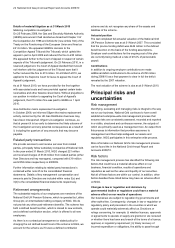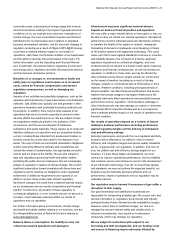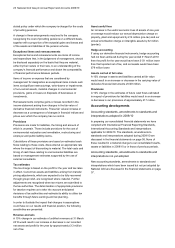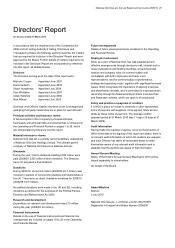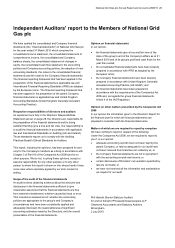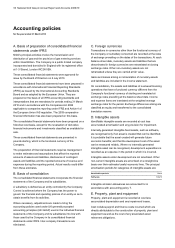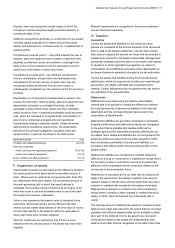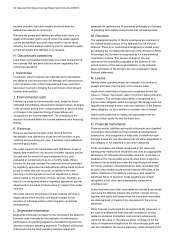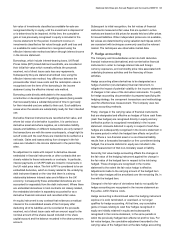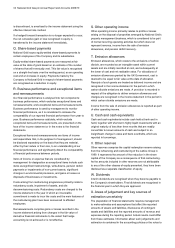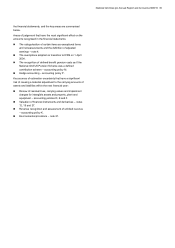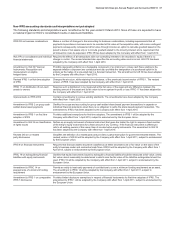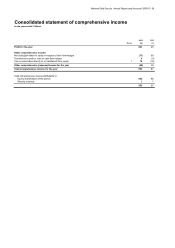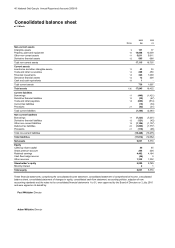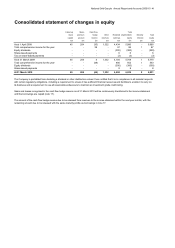National Grid 2010 Annual Report Download - page 34
Download and view the complete annual report
Please find page 34 of the 2010 National Grid annual report below. You can navigate through the pages in the report by either clicking on the pages listed below, or by using the keyword search tool below to find specific information within the annual report.32 National Grid Gas plc Annual Report and Accounts 2009/10
become probable that future taxable profit will allow the
deferred tax asset to be recovered.
Deferred tax assets and liabilities are offset when there is a
legally enforceable right to set off current tax assets against
current tax liabilities, and when they relate to income taxes
levied by the same taxation authority and it is intended to settle
current tax assets and liabilities on a net basis.
H. Discontinued operations
Cash flows and operations that relate to a major component of
the business that has been sold are shown separately from
continuing operations.
I. Inventories
Inventories, which comprise raw materials and consumables,
are stated at cost less provision for damage and obsolescence.
Cost comprises cost of direct materials and those costs that
have been incurred in bringing the inventories to their present
location and condition.
J. Environmental costs
Provision is made for environmental costs, based on future
estimated expenditures, discounted to present values. Changes
in the provision arising from revised estimates or discount rates
or changes in the expected timing of expenditures are
recognised in the income statement. The unwinding of the
discount is included within the income statement as a financing
charge.
K. Revenue
Revenue represents the sales value derived from the
transmission and distribution of gas and the provision of gas
metering services during the year. It excludes value added tax
and intra-group sales.
The sales value for the transmission and distribution of gas is
largely determined from the amount of system capacity sold for
the year and the amount of gas transported in the year,
evaluated at contractual prices on a monthly basis. Where
revenue for the year exceeds the maximum amount permitted
by regulatory agreement and adjustments will be made to future
prices to reflect this over-recovery, a liability for the over-
recovery is not recognised as such an adjustment to future
prices relates to the provision of future services. Similarly, an
asset is not recognised where a regulatory agreement permits
adjustments to be made to future prices in respect of an under-
recovery.
The sales value for the provision of gas metering services is
largely derived from monthly contractual charges for the
provision of individual meters under long-term contractual
arrangements.
L. Segmental information
Segmental information is based on the information the Board of
Directors uses internally for the purposes of evaluating the
performance of operating segments and determining resource
allocation between operating segments. The Board of Directors
is deemed to be the chief operating decision-maker and
assesses the performance of operations principally on the basis
of operating items before exceptionals and remeasurements.
M. Pensions
The substantial majority of NGG’s employees are members of
the defined benefit section of the National Grid UK Pension
Scheme. There is no contractual arrangement or stated policy
for charging the net defined benefit cost of the Scheme to NGG.
Accordingly, the Scheme is recognised as if it were a defined
contribution scheme. The pension charge for the year
represents the contributions payable to the Scheme for the
period. A share of the assets and liabilities, or the actuarial
gains and losses of the Scheme are not recognised in these
financial statements.
N. Leases
Rentals under operating leases are charged to income on a
straight-line basis over the term of the relevant lease.
Assets held under finance leases are recognised at their fair
value or, if lower, the present value of minimum lease payments
on inception. The corresponding liability is recognised as a
finance lease obligation within borrowings. Rental payments are
apportioned between finance costs and reduction in the finance
lease obligation, so as to achieve a constant rate of interest.
Assets held under finance leases are depreciated over the
shorter of their useful life and the lease term.
O. Financial instruments
Financial assets, liabilities and equity instruments are classified
according to the substance of the contractual arrangements
entered into, and recognised on trade date. Available-for-sale
financial assets are non-derivatives that are either designated in
this category or not classified in any other categories.
Trade receivables are initially recognised at fair value and
subsequently measured at amortised cost, less any appropriate
allowances for estimated irrecoverable amounts. A provision is
established for irrecoverable amounts when there is objective
evidence that amounts due under the original payment terms
will not be collected. Indications that the trade receivable may
become irrecoverable would include financial difficulties of the
debtor, likelihood of the debtor’s insolvency, and default or
significant failure of payment. Trade payables are initially
recognised at fair value and subsequently measured at
amortised cost.
Loans receivable and other receivables are carried at amortised
cost using the effective interest rate method. Interest income,
together with gains and losses when the loans and receivables
are derecognised or impaired, are recognised in the income
statement.
Other financial investments are recognised at fair value plus, in
the case of available-for-sale financial investments, directly
related incremental transaction costs and are subsequently
carried at fair value on the balance sheet. Changes in the fair
value of investments classified as fair value through profit and
loss are included in the income statement, while changes in the


